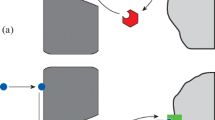Summary
Gustatory chemoreceptors on the maxillae ofManduca sexta responded to natural stimuli from distances of up to 600 μm (average is 100 μm). In the lateral sensilla styloconica, at least three of the four known chemoreceptive cells responded, indicating that different compounds could be involved in the stimulus. The medial sensilla did not show a comparable olfactory capability. Thus, chemoreceptors classed as contact receptors on a morphological basis (thick walls, single apical pore) were responsive to vapors of normal food substances. Adaptation of the receptor was observed prior to contact with the stimulus. This has important implications for experiments on gustatory receptors.
Similar content being viewed by others
References
Bernays, E. A., Mordue (Luntz), A. J.: Changes in the palp tip sensilla ofLocusta migratoria in relation to feeding: The effect of different levels of hormone. Comp. Biochem. Physiol.45A, 451–454 (1973)
Dethier, V. G.: Sensitivity of the contact chemoreceptors of the blowfly to vapors. Proc. nat. Acad. Sci. (Wash.)69, 2189–2192 (1972)
Dethier, V. G., Schoonhoven, L. M.: Evaluation of evaporation by cold and humidity receptors in caterpillars. J. Insect Physiol.14, 1049–1054 (1968)
Dethier, V. G., Kuch. J. H.: Electrophysiological studies of gustation in lepidopterous larvae. I. Comparative sensitivity to sugars, amino acids and glycosides. Z. vergl. Physiol.72, 343–363 (1971)
Hanson, F. E.: Sensory responses of phytophagous Lepidoptera to chemical and tactile stimuli. In: Control of insect behavior by natural products. (Wood, D. L., Silverstein, R. M. and Nakajima, M., eds.), p. 81–91. New York: Academic Press 1970
Hanson, F. E., Dethier, V. G.: Rôle of gustation and olfaction in food plant discrimination in the tobacco hornworm,Manduca sexta. J. Insect Physiol.19, 1019–1034 (1973)
Jermy, T., Hanson, F. E., Dethier, V. G.: Induction of specific food preference in lepidopterous larvae. Ent. exp. & appl.11, 211–230 (1968)
Ma, W. C.: Dynamics of feeding responses inPieris brassicae Linn. as a function of chemosensory input: A behavioural, ultrastructural and electrophysiological study. Mededelingen Landbouwhogeschool, Wageningen,72-11, 1–162 (1972)
Schoonhoven, L. M.: Some cold receptors in larvae of three lepidoptera species. J. Insect Physiol.13, 821–826 (1967)
Schoonhoven, L. M.: Gustation and foodplant selection in some lepidopterous larvae. Ent. exp. & appl.12, 555–564 (1969a)
Schoonhoven, L. M.: Sensitivity changes in some insect chemoreceptors and their effect on food selection behaviour. Koninkl. Ned. Akad. Wet., Proc. Ser. C72, 491–498 (1969b)
Schoonhoven, L. M.: Plant recognition by lepidopterous larvae, 87–99. In: Insect/plant relationships (van Emden, H. F., ed.). Oxford: Blackwell Scientific Publ. 1972a
Schoonhoven, L. M.: Some aspects of host selection and feeding in phytophagous insects. In: Insect and mite nutrition (Rodriguez, J. G., ed.), p. 557–566. Amsterdam: North Holland Publ. 1972b
Schoonhoven, L. M.: On the variability of chemosensory information. In: The host plant in relation to insect behaviour and reproduction (Jermy, T., ed.). Proc. Hungarian Acad. Sci. (in press) 1975
Schoonhoven, L. M., Dethier, V. G.: Sensory aspects of host-plant discrimination by lepidopterous larvae. Arch. Néérl. Zool.16, 497–530 (1966)
Slifer, E. H.: The structure of arthropod chemoreceptors. Ann. Rev. Ent.15, 121–142 (1970)
Städler, E., Hanson, F. E.: Influence of induction of host preference on chemoreception ofManduca sexta: Behavioural and electrophysiological studies. In: The host plant in relation to insect behaviour and reproduction (Jermy, T., ed.). Proc. Hungarian Acad. Sci. (in press) 1975
Author information
Authors and Affiliations
Additional information
The authors thank Dr. J. N. Kaplanis (USDA, Beltsville) and his assistants for supplying eggs ofManduca sexta and Mrs. Patti Filip for help with rearing the larvae. We are indebted to Dr. V. G. Dethier (Princeton University, USA) and Dr. L. M. Schoonhoven (Agricultural University, Wageningen, The Netherlands) for their critical review of the manuscript and to Mr. George Johnson (UMBC) for electronics assistance and other technical suggestions. This research was supported by U.S.P.H.S. Grant No. NS-10760 to F.H. and a postdoctoral fellowship of the Swiss Federal Institute of Technology in Zürich to E.S.
Rights and permissions
About this article
Cite this article
Städler, E., Hanson, F.E. Olfactory capabilities of the “gustatory” chemoreceptors of the tobacco hornworm larvae. J. Comp. Physiol. 104, 97–102 (1975). https://doi.org/10.1007/BF01379454
Received:
Issue Date:
DOI: https://doi.org/10.1007/BF01379454




